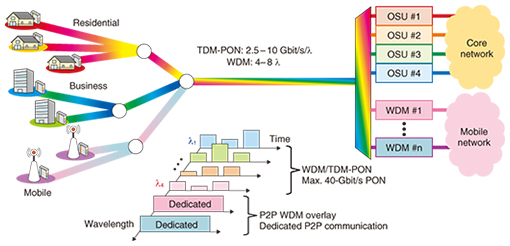 |
|||||||||||||||||
|
|
|||||||||||||||||
|
Feature Articles: NTT Tsukuba Forum 2015 Workshop Lectures Vol. 14, No. 4, pp. 41–46, Apr. 2016. https://doi.org/10.53829/ntr201604fa6 
Access System Technologies for Service DiversificationAbstractNTT Access Service Systems Laboratories has been actively conducting research and development (R&D) of the fiber-to-the-home (FTTH) service for the access system. FTTH was commercially introduced some 20 years ago. This article reviews the technical innovations created for FTTH systems and discusses current R&D activities in access system technologies focused on the diversification of services. Keywords: FTTH, access system technologies, access services 1. Advances in access services and system technologies1.1 Initial commercial FTTHThe fiber-to-the-home (FTTH) service in Japan is currently being used by more than 26 million users. Its growth has followed the rapid adoption of Internet access, and it is now a key communication infrastructure. Commercial FTTH service started in Japan in 1997, and its system technologies have greatly advanced over the last 20 years or so. The initial FTTH services provided analog/ISDN (integrated services digital network) phone system communication and analog multi-channel video distribution. Two technologies dominated this period: synchronous transfer mode passive optical network (STM-PON) systems for the telephony-based services and SCM-PON (sub-carrier multiplexing PON) for the video distribution services. The access system transferred both services over the same optical fiber by using wavelength division multiplexing (WDM) [1]. A PON with a 32-branch splitter was adopted as the physical topology of the access network. The first FTTH systems were rather slow, about 16 Mbit/s, but this was acceptable since the dominant service was telephony. However, the original idea of providing access services via a WDM-based PON system carrying optical signals corresponds to the current FTTH (Fig. 1).
1.2 FTTH broadband accessThe advent of the new millennium in 2000 saw a major change to access services. The conventional telephony service was replaced by Internet access as the dominant traffic source. In early 2000, we developed and introduced a system that could take full advantage of the STM-PON described above to realize bandwidths of up to 10 Mbit/s. This move was driven by the need to eliminate the speed restrictions of ADSL (asymmetric digital subscriber line), a high-speed metallic communication system. In 2002, we developed the B-PON (broadband PON) based on ATM-PON (asynchronous transfer mode PON) for data communication [2]. The next advance was the introduction of the Gigabit Ethernet-PON (GE-PON) based on Ethernet technology in 2004 [3]. Consequently, access system speeds rose from 12 Mbit/s to 1 Gbit/s in just a few years. The major enabler has been the adoption of high-speed local area network (LAN) technology, which has become very cost-effective with the release of international standards such as those specified by the Institute of Electrical and Electronics Engineers (IEEE) and the Telecommunication Standardization Sector of the International Telecommunication Union (ITU-T), as well as the subsequent commercial development of a full spectrum of devices [4]. Prior systems largely used proprietary interfaces, and hardware was expensive and inflexible. Costs were further reduced by replacing the complex telephone system interface with Internet access, which greatly simplified the system hardware. As the full-scale deployment of FTTH for broadband access progresses, further development has been undertaken to provide support for various services such as NGN (Next Generation Network), multicast, and BS (broadcasting satellite)/CS (communication satellite) signals, as well as the mass adoption of services thanks to DIY (do it yourself) installation and optical network unit (ONU) integration. Support has also been provided for expanding the service area (transmission coverage enhancement) and adding functions for power saving. These technological developments have enabled current services to be accepted by about 19 million users as a stable and effective communication infrastructure (Fig. 2).
2. Current efforts in access system technology development2.1 Technologies to handle the increase in trafficOver the last ten years of FTTH use, broadband traffic has increased 14-fold (Fig. 3). This trend is strongly expected to continue or even increase in the future with the spread of rich content services such as high-definition video. A similar trend is the continued growth in mobile communications traffic. The strong growth of 50% or more every year, driven in most part by the popularity of smartphones, has triggered significant challenges with regard to bandwidth enhancement of the backbone of the mobile network.
A recent solution is to use the optical access network as the backbone that links mobile base stations. It is obvious that continuous improvement in the access system is essential in order to continue to support broadband access and mobile communications traffic. Near-term advances in access system technologies include the PON system offering high-speed transmission at 10 Gbit/s. This system has been thoroughly studied and adopted in the IEEE802.3av and ITU-T G.987 series of standards [5]. Unfortunately, focusing only on high-speed optical access systems will not be sufficient to support the explosive diversification in access traffic; a key requirement is flexibility in system operation. WDM/TDM-PON [6] is a system that integrates time division multiplexing PON (TDM-PON) into the conventional WDM-PON (Fig. 4). This technology is currently being standardized as NG-PON2 (Next Generation PON 2) in ITU-T. Each TDM-PON provides speeds of 2.5–10 Gbit/s, and PON speeds of up to 40 Gbit/s can be achieved by assigning four TDM-PONs to one service. Additionally, the dynamic allocation of the communication wavelength of any ONU-OSU (optical subscriber unit) link enables changes such as flexible speed setting and recovery after failure. Moreover, the technology of simultaneous WDM overlay point-to-point (P2P) enables this PON to establish multiple communication streams independently. This flexibility allows the access network to provide services for residences and businesses at the same time as it provides mobile communications (Fig. 4).
2.2 Technologies for mobile fronthaulThe mobile fronthaul (MFH) optically links the base band unit (BBU) in the base station to the remote antennas of the remote radio heads (RRHs). The BBU is connected to the backbone network and uses digital signal processing to generate an optical signal that carries the radio signal to be transmitted. The MFH uses the Common Public Radio Interface (CPRI), which directly digitizes the radio signal, and therefore, the required bandwidth of the optical signal is roughly 16 times that of the radio signal. CPRI is quite simple but demands very high-speed optical links. In the future, mobile communications will shift from the current LTE (Long Term Evolution) and LTE-Advanced to 5G (fifth generation), which offers up to 10 Gbit/s. This will make the current CPRI a hurdle to economical deployment of RRH, as the MFH would need access speeds in excess of 100 Gbit/s (Fig. 5).
Therefore, in order to achieve a cost-effective MFH that supports the traffic demands of future mobile communications, the functional configuration of the physical layer of a conventional BBU was revised so that the optical bandwidth is only slightly greater than the wireless signal speed [7]. Specifically, the new technology allows tight cooperation between base stations while reducing the interface speeds by at least 90% from the conventional CPRI demands. This advance in MFH efficiency will encourage the installation of mobile base stations. For example, even when the MFH supports 5G, the optical interface of 10 Gbit/s used in the commercial LAN or the like can be employed, which will allow low-cost commercial technology to be adopted. In addition, advances that make the MFH a better fit to PON can be expected, creating even more economical and more efficient operation. 3. Towards the next research and technological development area3.1 Emerging services and networksExisting communication is focused on person to person communication, but the past few years have seen the rise of communication for machine to machine (M2M) and Internet of Things (IoT) applications, where the emphasis is on connecting people to things and connecting things to things. This is creating new services and business opportunities. Research on autonomous driving is underway in many fields, but if Japanese automobiles, some 80 million units, are connected to the network, the entity of the terminal will rise in importance. In addition, recent predictions suggest that devices such as sensors totaling some 50 billion units or more will be connected as terminals to the network around the world by 2020, but even this number is less than the true total. In a world where such a vast number of devices/terminals are connected to the network, we must consider the possibility that the access network, currently structured for FTTH, will need to be radically altered. For example, the M2M area network or backbone network is not likely to be layered in the same way as in the current access relay approach. Moreover, the network technologies used do not seem to suit integration (Fig. 6). In addition, discussions are ongoing about the actual characteristics of the information to be sent to and received by these devices. This background makes it clear that creating a network for the M2M/IoT era, assumed to be provided as an access service, is a new and very large field of research and development (R&D).
3.2 Application areas of technologyNTT Access Service Systems Laboratories has developed numerous access system technologies. A close look at each of our advances in technology is likely to reveal other areas in which they can be of benefit. For example, recently developed optical time domain reflectometry (OTDR) techniques can accurately measure the loss of optical fiber. OTDR makes it possible to not only locate faults in the optical fiber network but also to identify physical changes such as bending in the optical fiber. This makes it possible to track the status of objects that carry the fiber such as river embankments and bridges [8]. Similarly, more consideration should be given to the alternative application of the individual technologies developed for the PON as parts. For example, the algorithms developed to prevent optical signal collision can be used to control logistic systems. Of course, we are always alert to the possibility of adopting technology developed in other fields to rectify any problems in network technologies that may be necessary. During the Tsukuba Forum, our laboratories’ core technologies are being presented under the categories of access system technology, operation technology, and network infrastructure technology. However, if we regard them as parts instead of being bound by these three categories, we might be able to maximize their application range. We are aggressively pursuing collaboration with partners in new areas in order to exchange viewpoints and share understandings from various quarters. 4. Future prospectsThe strengthening of service diversification has led to the diversification of themes directing our R&D activities. At NTT Access Network Service Systems Laboratories, in addition to developing access system technologies to achieve goals such as high-speed, broadband, and M2M technology, our vision is to approach R&D from a new perspective that includes the IoT, involving applications that far exceed what has been thought possible. We will continue to challenge ourselves to explore the widest possible range of R&D activities. References
■Author profileYukihiro FujimotoGeneral Manager, Optical Access Network Service System Project, NTT Access Network Service Systems Laboratories. He received a B.A. from Nagasaki University in 1988 and an M.S. from University of Tsukuba in 1990. He joined NTT Telecommunication Networks Laboratories in 1990 and studied fiber optic access networks including optical access systems, cables, and deployment scenarios. During 1997–1998, he was a guest researcher at Lucent Technologies Bell Lab (now a part of Nokia) in the Netherlands, where he developed the Pai-PON system, an STM-PON system for telephony services. At NTT, he has been active in writing the IEEE802.3ah specifications and in developing the GE-PON system for commercial FTTH services. He is currently studying access networks for emerging services. He is a member of the Institute of Electronics, Information and Communication Engineers and IEEE. |
|||||||||||||||||














